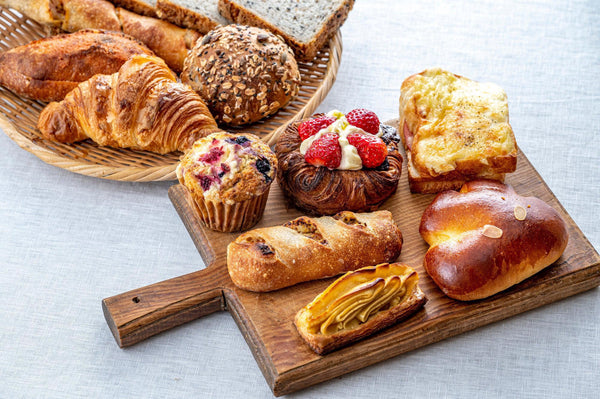
Jump to:
Bread has become one of the most popular meal or snack options in Japan. It’s quick, filling, can be sweet or savory, and is most importantly delicious. When you think of Japanese cuisine, maybe bread isn’t the first option that comes to mind. Rice is the staple-carbohydrate in the Japanese diet, but these days, more and more Japanese people are also incorporating bread into their diets. For busy mornings or times where there is no time, bread takes the cake for being a fast meal or snack.
But wait, we’re not only talking about plain bread here. In Japan, there are so many different kinds of bread ranging from sweet to savory, filled or topped with flavorful ingredients. The possibilities and options of Japanese bread are endless. So now, if your mouth isn’t already watering, maybe you’re wondering: What are the most popular breads in Japan? Which bread should I try when I come to Japan?
No worries, we’ve got you covered from here. We’re going to give you the lowdown, or 101 on Japanese bread.
In this article, we'll cover:
- Characteristics of Japanese breads
- Where to find delicious bread in Japan
- The standard Japanese bread - shokupan
- 3 Sweet Japanese breads
- 4 Savory Japanese breads
What makes Japanese Bread Unique?
Japanese bread has quite a different reputation from European or other western breads. It's very soft, has a pillowy texture, and is slightly sweet. Flavorwise, it is not too strong and can be paired with both sweet and savory ingredients.
Where to buy Japanese Bread
Bread in Japan can be found almost anywhere, literally. From fancy bakeries or bread shops, to supermarkets, to convenience stores, no matter where you purchase your bread from, you are guaranteed to end up with a delicious snack or meal. The best part is that the varieties are endless. There are many variations of Japanese bread, but let’s start with the basics.

The Standard Japanese Bread
The standard Japanese bread is known as Shokupan (食パン). Shokupan can be purchased as a whole loaf, sliced or unsliced. Depending on the number of slices, it may also come in thick or thin slices. It has become a staple item that can be found in most Japanese households. Commonly described as ‘milk bread’ overseas, it is famous for its soft, fluffy texture and milky flavor. It is a white bread with a mild sweetness that will compliment whatever you decide to pair it with. This is typically the bread used for sandwiches in Japan, but you can even make a quick snack called pizza toast with it!

Sweet Breads
Next, let’s move on to some sweet varieties of Japanese bread, also known as Kashipan (菓子パン). Kashipan typically feature a round shape, and contain a sweet filling or topping. The bread used for kashipan is also famous for having a brioche-like soft and fluffy texture. The most popular kashipan are anpan, creampan, and melon pan.
Anpan

Anpan (アンパン) might be described as the most “traditional” kashipan. Though bread is clearly not a traditional Japanese food, anpan was created to have a classic taste that would be familiar for Japanese people. In fact, anpan was created in 1874 by a man named Yasube Kimura in Tokyo. He believed that bread filled with sweetened red bean paste (anko in Japanese) would be a huge hit among the Japanese. He was not wrong. Anpan has since remained a beloved Japanese bread item, and the Japanese cartoon character anpanman was even created after this cherished bread.
Cream Pan

Another common kashipan in Japan is a cream-filled bread literally referred to as Creampan (クリームパン). This is an absolutely adored bread item among Japanese people, with significant roots. It is believed that creampan was invented in the early 1900s, by the owner of one of the oldest Japanese bread companies. The idea was to take the custard from commonly enjoyed choux cream or cream puffs, and fill it inside of bread. There are two versions of cream pan - one with the custard filled into the bread and baked together, and one with custard filled into the bread after it has been baked.
This bread is best enjoyed warm, and is a much-purchase item from a Japanese bakery when they are fresh out of the oven! The custard is famous for being soft and having a nice mouthfeel. Creampan can be enjoyed as a snack or dessert. They are not overly sweet but are super satisfying. While the classic flavor is ‘plain’ for cream pan, there are also matcha and chocolate varieties available in some bakeries.
Melon Pan

Maybe a more well-known Japanese bread abroad is Melon pan (メロンパン). Melon pan is a popular Japanese bread that literally looks like a melon. Though melon is its name, this bread traditionally does not contain any melon flavoring. Melon pan, similar to that of creampan and anpan, features a brioche-like bread dough, but what sets it apart from its filled-bread counterparts is its crisp, cookie dough topping. You can enjoy the contrast between a soft, pillowy fluffy texture and crispy cookie texture at the same time when you take a bite into a melonpan.
While the plain flavor is the most traditional and commonly sold kind, there are also other flavors including chocolate chips, caramel, maple syrup, matcha, or even melon cream. Melon pan does not traditionally contain a filling, but some bakeries add custard or whipped cream into their melon pan to make it more unique.
Melon pan may also be referred to differently depending on the region. For example, melon pan is called sunrise pan (サンライズパン) in Western Japan. In fact, the name originates from Kobe city in Hyogo prefecture. However, everyone in Japan will be able to recognize melon pan by its original name and appearance.
Savory Breads

Now, let’s talk about savory variations of Japanese bread, commonly known as chouripan (調理パン) or souzaipan (惣菜パン). There are also Japanese breads filled with savory fillings, but the shape and type of bread can vary. These breads are much more satiating than kashipan, so they can be enjoyed as a meal rather than a snack.
Curry Pan

Let’s start with Curry Pan (カレーパン), a bread filled with flavorful curry, breaded in panko, and deep fried or baked. The curry filling usually consists of beef, pork, or chicken curry, but some shops sell a meat-free alternative. Cheese is sometimes included in the curry mix or on top of the bread. The bread used for curry pan is brioche-like, similar to kashipan. This is the perfect bread for those who love Japanese curry.
Yakisoba Pan

Yakisoba Pan (焼きそばパン) is another popular savory bread. Maybe you’re already familiar with Yakisoba, or Japanese grilled noodles, but did you know that they sell sandwiches with yakisoba as a filling in Japan? Yes, it is a complete carb overload, but it is also delicious. For this style of bread, a bread similar to a hot dog bun, called koppepan (コッペパン) is used, so it has more of an open-faced sandwich vibe.
This savory carb-lover’s dream features Japanese koppepan, buttered and stuffed with flavorful yakisoba. It is commonly garnished with red pickled ginger and dried seaweed. Though stuffing bread with noodles may sound a bit odd, this is definitely a must try bread. If you are a carb-lover, you cannot miss out on yakisoba pan.
Katsu Sando

As we move more into the sandwich category of Japanese bread, a popular sandwich option sold in Japanese bakeries is Katsusando (カツサンド). Katsusando features a panko crusted, deep-fried pork or chicken cutlet, sandwiched between 2 slices of fluffy shokupan. The bread is dressed with mayonnaise and tonkatsu sauce. Shredded cabbage is usually added to provide an extra crunch to the sandwich.
Katsusando is a perfect quick lunch option, as it contains carbs and protein. It may not be the healthiest, but it is a hearty and satiating sandwich that everyone should try. The mayonnaise and tonkatsu sauce added provide the sandwich with a slight acidic flavor that cuts the richness of the meat and shokupan. The cabbage also provides a nice textural element, by giving the sandwich a light but satisfying crunch.
Mentai Furansu

Last, but surely not least is an option that may not be as well known overseas, but it is well-loved by many Japanese. It’s called Mentai furansu (明太フランス). Mentai furansu combines the flavors of mentaiko, or pollock roe, with a french-style baguette. Maybe combining the flavors of the ocean onto a baguette sounds quite strange, but the Japanese bread option is packed with umami flavor, and is a unique-to-Japan item.
This is the only bread on this list that does not use soft bread. The baguette used for mentai furansu is much crustier than shokupan, but is slightly softer than the traditional French baguette. This bread can usually be found in bakeries across Japan, but is also available in some convenience stores. It’s basically a French-inspired baguette with mentaiko spread across the surface and baked together. It is usually garnished with thinly sliced nori or Japanese seaweed. Mentaiko has a quite briny, umami, ocean-like flavor. The nori elevates the ocean flavor a little more, giving the baguette a unique flavor that cannot be found easily overseas.
Mentai furansu was originally invented in Fukuoka prefecture, located in the Southwestern region of Japan. Though mentai furansu is nowadays sold in bakeries and convenience stores across Japan, it us a local specialty to Fukuoka. You can enjoy a sense of Fukuoka regionalism and French inspiration with mentai furansu, so it is definitely worth a try.


0 comments